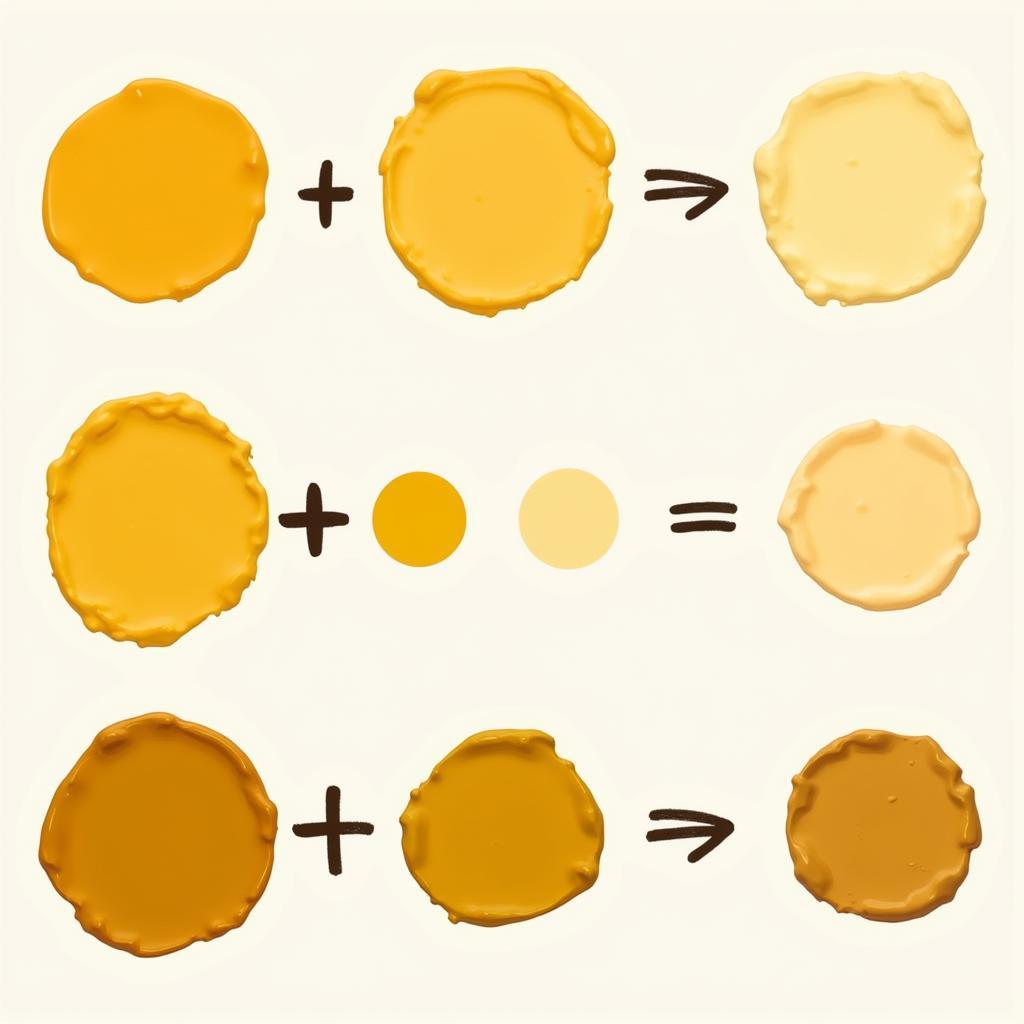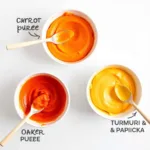Mustard yellow, a warm and inviting hue, brings a touch of vintage charm and earthy sophistication to any space or project. Whether you’re an artist, a DIY enthusiast, or simply looking to refresh your home decor, understanding how to mix mustard color offers a world of creative possibilities. This guide will explore the nuances of creating this versatile color, offering practical tips and expert insights to achieve the perfect shade of mustard.
Mixing your own mustard allows for complete control over the final hue, enabling you to achieve a custom color that perfectly complements your vision. From subtle variations in tone to vibrant, bold statements, the ability to mix mustard opens doors to a unique and personalized color palette. Let’s delve into the world of color mixing and discover the secrets to creating this captivating shade. Thinking about coordinating your new color with existing furniture? Check out what colors go with a taupe couch for some inspiration.
Decoding the Mustard Palette: Understanding the Basics
Mustard yellow is a complex color, a blend of yellow, red, and a touch of brown or green. This intricate combination gives it its signature depth and warmth, setting it apart from brighter, primary yellows. To achieve the desired shade, understanding the interplay of these base colors is crucial.
Primary Colors: Your Building Blocks
The journey to mixing mustard begins with the primary colors: red, yellow, and blue. These foundational colors form the basis of all other hues. For mustard, we’ll focus primarily on red and yellow, with blue playing a supporting role in achieving subtle variations.
Secondary Colors: Expanding the Spectrum
Combining two primary colors yields a secondary color. Orange, created by mixing red and yellow, plays a significant role in achieving the warm undertones characteristic of mustard. Understanding this relationship will guide you in fine-tuning your color mixture.
Step-by-Step Guide: Mixing Mustard Color
Creating the perfect mustard involves a careful and measured approach. Follow these steps to achieve the desired result:
- Start with a Base of Yellow: Begin with a pure, vibrant yellow as your foundation. This will determine the overall brightness of your mustard.
- Introduce Red Gradually: Slowly add red to your yellow base, mixing thoroughly after each addition. The amount of red you add will determine the intensity of the orange undertones and the overall warmth of the mustard.
- Adding Depth with Brown or Green: For a deeper, more muted mustard, incorporate a small amount of brown or green. Brown will create a more earthy tone, while green will lend a slightly olive hue. Experiment with these additions to achieve the desired nuance.
- Adjusting the Tone: To lighten your mustard, add a touch of white. To darken it, incorporate a small amount of black or a complementary color like purple or blue. These adjustments allow for fine-tuning and customization.
 Mixing Mustard Color with Primary Colors
Mixing Mustard Color with Primary Colors
Mastering the Art of Mixing: Tips and Techniques
Achieving consistent and accurate results when mixing colors requires understanding a few key techniques:
- Start Small: Begin with small amounts of color and gradually add more until you achieve the desired shade. This prevents waste and allows for greater control over the final result.
- Mix Thoroughly: Ensure that the colors are completely blended to avoid streaks or uneven patches. Use a palette knife or a similar tool to achieve a smooth and uniform mixture.
- Test Your Color: Before applying your mixed mustard to your final project, test it on a small, inconspicuous area to ensure it matches your expectations. This is particularly important when painting walls or furniture. If you’re looking for cabinet color ideas to match gray walls, we have a guide that could be helpful.
Common Questions About Mixing Mustard Color
What if my mustard color is too orange? If your mixture leans too heavily towards orange, add more yellow to balance the red. Small adjustments will help you achieve the desired mustard hue.
What if my mustard color is too dull? If your mustard lacks vibrancy, try adding a touch more pure yellow to brighten it. Alternatively, a small amount of white can lighten the overall tone without sacrificing the mustard hue.
Expert Insights: A Conversation with Amelia Hues, Color Specialist
“Mustard yellow is a truly versatile color,” says Amelia Hues, a renowned color specialist. “Its warm undertones make it a great choice for creating inviting and cozy spaces, while its unique depth adds a touch of sophistication.” Amelia emphasizes the importance of understanding the interplay of colors. “Experimentation is key,” she advises. “Don’t be afraid to play with different ratios of red, yellow, and brown or green to discover your perfect mustard.” Finding the right bedding color to complement your gray walls can also create a harmonious atmosphere.
“Mustard is a color that evokes a sense of nostalgia and warmth,” adds Amelia. “It’s a classic choice that can be used in a variety of settings, from traditional to contemporary.” She suggests considering the surrounding colors when incorporating mustard into a design. “Think about how the mustard will interact with other elements in the space,” she recommends. “For example, pairing mustard with navy blue creates a striking contrast, while combining it with earthy tones creates a more harmonious and grounded feel.” Choosing the right color pants with a black blazer can make a world of difference.
Conclusion: Unleashing Your Inner Colorist
Mixing mustard color opens up a world of creative expression, allowing you to customize and personalize your projects. By understanding the basic principles of color mixing and following the step-by-step guide outlined above, you can achieve the perfect shade of mustard for any application. From vibrant and bold to subtle and nuanced, the possibilities are endless. Remember to experiment, practice, and embrace the journey of color discovery. How to mix mustard color is just the beginning of your colorful adventure.
FAQs
- What are the primary colors used to mix mustard? Red and yellow are the primary colors, with blue or brown added for nuance.
- How do I make mustard yellow darker? Add a small amount of black or a complementary color like purple or blue.
- Can I mix mustard with acrylic paints? Yes, the principles of color mixing apply to various paint types, including acrylics.
- What colors complement mustard yellow? Navy blue, gray, and earthy tones like brown and green complement mustard well. Learn how to mix forest green for more options.
- What if my mustard is too bright? Add a touch of brown or a complementary color to mute the brightness.
Contact Us
Need help with your color choices? Contact us at:
Phone: 0373298888
Email: SEO.backlink@gmail.com
Address: 86 Cầu Giấy, Hà Nội
Our customer service team is available 24/7.

